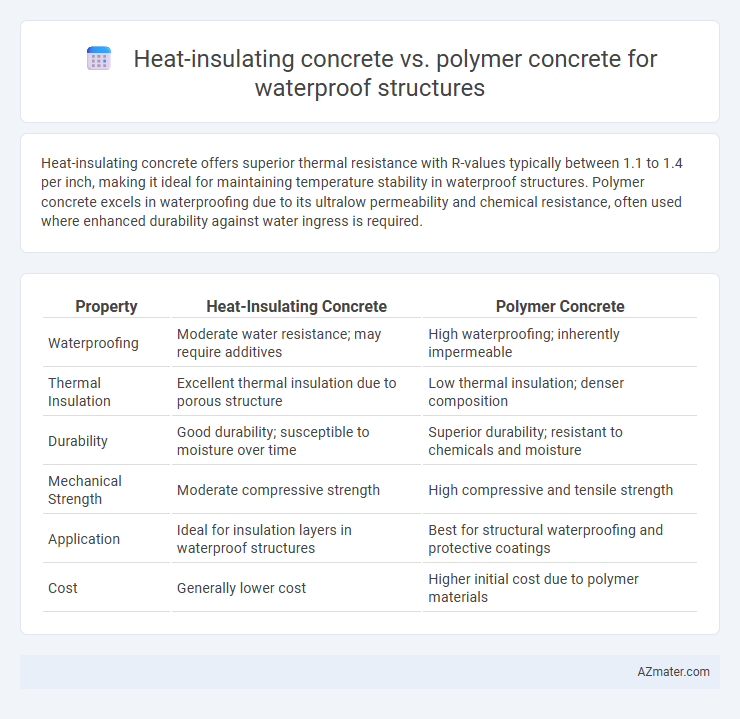Heat-insulating concrete offers superior thermal resistance with R-values typically between 1.1 to 1.4 per inch, making it ideal for maintaining temperature stability in waterproof structures. Polymer concrete excels in waterproofing due to its ultralow permeability and chemical resistance, often used where enhanced durability against water ingress is required.
Table of Comparison
| Property | Heat-Insulating Concrete | Polymer Concrete |
|---|---|---|
| Waterproofing | Moderate water resistance; may require additives | High waterproofing; inherently impermeable |
| Thermal Insulation | Excellent thermal insulation due to porous structure | Low thermal insulation; denser composition |
| Durability | Good durability; susceptible to moisture over time | Superior durability; resistant to chemicals and moisture |
| Mechanical Strength | Moderate compressive strength | High compressive and tensile strength |
| Application | Ideal for insulation layers in waterproof structures | Best for structural waterproofing and protective coatings |
| Cost | Generally lower cost | Higher initial cost due to polymer materials |
Introduction to Waterproof Structures
Heat-insulating concrete enhances waterproof structures by providing superior thermal resistance, reducing heat transfer, and preventing moisture condensation that can weaken the integrity of the material. Polymer concrete offers excellent waterproofing properties due to its chemical resistance and reduced permeability, making it suitable for environments exposed to aggressive water conditions. Both materials improve durability and lifespan of waterproof structures, but selection depends on specific thermal and chemical exposure requirements.
Overview of Heat-Insulating Concrete
Heat-insulating concrete utilizes lightweight aggregates such as expanded polystyrene beads or perlite to significantly reduce thermal conductivity while maintaining structural strength, making it ideal for energy-efficient waterproof structures. Its porous microstructure effectively traps air, providing superior insulation and moisture resistance compared to traditional concrete types. This material is commonly used in building envelopes where thermal performance and waterproofing are critical for durability and energy conservation.
Key Properties of Polymer Concrete
Polymer concrete exhibits exceptional chemical resistance, high compressive strength, and low permeability, making it ideal for waterproof structures. Its rapid curing time and superior adhesion to various substrates enhance the durability and integrity of water-retaining facilities. Compared to heat-insulating concrete, polymer concrete offers better waterproofing performance and long-term protection against moisture ingress and chemical degradation.
Thermal Performance Comparison
Heat-insulating concrete exhibits superior thermal resistance due to its lightweight aggregates and porous structure, reducing heat transfer significantly in waterproof structures. Polymer concrete, while offering excellent chemical and moisture resistance, typically has a higher thermal conductivity, leading to less effective insulation under thermal loads. Choosing heat-insulating concrete enhances energy efficiency in waterproof applications by minimizing thermal bridging and maintaining stable internal temperatures.
Waterproofing Capabilities: A Comparative Analysis
Heat-insulating concrete offers moderate waterproofing capabilities due to its dense matrix and integrated additives that reduce water permeability. Polymer concrete exhibits superior waterproofing performance, as its polymer binder creates a non-porous, chemical-resistant barrier preventing water ingress and enhancing durability in wet environments. Comparative studies demonstrate polymer concrete's enhanced resistance to hydrostatic pressure and chloride ion penetration, making it the preferred choice for waterproof structural applications.
Durability and Longevity in Wet Environments
Heat-insulating concrete exhibits enhanced durability and longevity in wet environments due to its low thermal conductivity and resistance to moisture penetration, which reduces the risk of freeze-thaw damage and structural degradation. Polymer concrete offers superior waterproofing capabilities with excellent chemical resistance and flexibility, minimizing crack formation and water ingress over time. Both materials provide long-term protection against water damage, but polymer concrete generally outperforms in highly corrosive or variable moisture conditions, extending the lifespan of waterproof structures.
Installation and Maintenance Considerations
Heat-insulating concrete offers superior thermal resistance and typically requires longer curing times during installation, demanding careful moisture control to prevent cracks, while polymer concrete cures faster and allows for quicker installation with minimal shrinkage. Maintenance of heat-insulating concrete involves regular inspections for thermal degradation and potential water ingress, whereas polymer concrete requires less frequent upkeep due to its enhanced chemical and water resistance. Both materials benefit from professional application to ensure waterproof integrity, but polymer concrete's chemical bonding reduces maintenance needs in harsh environments.
Cost Analysis: Initial and Lifecycle Expenses
Heat-insulating concrete typically involves higher initial material costs due to specialized additives for thermal resistance but offers long-term savings through reduced energy consumption in waterproof structures. Polymer concrete demands a higher upfront investment because of costly polymer resins yet requires less maintenance and exhibits superior durability, lowering lifecycle expenses. Cost analysis reveals heat-insulating concrete excels in energy efficiency benefits, while polymer concrete minimizes repair costs, making the choice dependent on project priorities and environmental conditions.
Environmental Impact and Sustainability
Heat-insulating concrete offers superior thermal resistance by incorporating lightweight aggregates and insulating materials, reducing energy consumption in buildings and lowering carbon footprints. Polymer concrete, composed of polymer binders instead of cement, exhibits enhanced chemical resistance and durability, minimizing maintenance needs and extending the lifespan of waterproof structures, which contributes to resource conservation. The lower embodied energy and recyclability potential of polymer concrete combined with the energy-saving benefits of heat-insulating concrete make both materials viable sustainable options depending on specific environmental priorities.
Best Use Cases: Choosing the Right Concrete for Your Project
Heat-insulating concrete excels in applications requiring thermal resistance and energy efficiency, such as building envelopes and cold storage facilities, where maintaining temperature control is critical. Polymer concrete, known for its superior chemical resistance and waterproofing capabilities, is ideal for structures exposed to aggressive environments like wastewater treatment plants, chemical processing units, and marine constructions. Selecting between the two depends on project priorities: prioritize heat-insulating concrete for insulation and comfort, and polymer concrete for robust waterproofing and durability against corrosive elements.

Infographic: Heat-insulating concrete vs Polymer concrete for Waterproof structure
 azmater.com
azmater.com